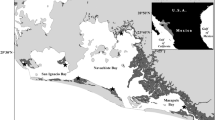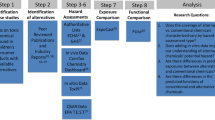Abstract
A toxicokinetic model has been optimized to describe the time profiles of common biomarkers of exposure to permethrin and cypermethrin: trans-3-(2,2-dichlorovinyl)-2,2-dimethylcyclopropane-1-carboxylic acids (trans-DCCA) and 3-phenoxybenzoic acid (3-PBA). The model then served to reproduce urinary time courses in exposed agricultural workers and predict corresponding absorbed doses. It allowed for the prediction of the main routes of exposure in workers during the study period. Modeling showed that simulating exposure mostly by the oral route, during the 3-day biomonitoring period, provided best-fits to the urinary time courses of most workers. This is compatible with an inadvertent oral exposure during work. According to best-fit scenarios, absorbed doses in workers reconstructed with the model reached a maximum of 2.4 µg/kg bw/day and were below the absorbed dose limits associated with an exposure to the reference dose values established by the U.S. Environmental Protection Agency (0.06 and 0.25 mg/kg bw/day for cypermethrin and permethrin, respectively) and the Acceptable Operator Exposure Level set by the European Commission (0.06 mg/kg bw/day for cypermethrin). Modeling was further used to derive biological reference values for cypermethrin and permethrin exposure. Respective values of 7 and 29 nmol/kg bw/day of trans-DCCA, and 3 and 13 nmol/kg bw/day of 3-PBA were obtained. None of the workers presented values above these biological reference values.
This is a preview of subscription content, access via your institution
Access options
Subscribe to this journal
Receive 6 print issues and online access
$259.00 per year
only $43.17 per issue
Buy this article
- Purchase on Springer Link
- Instant access to full article PDF
Prices may be subject to local taxes which are calculated during checkout





Similar content being viewed by others
References
Gorse I, Balg C. Bilan des ventes de pesticides au Québec pour l’année. 2010. Québec, ministère du Développement durable, de l’Environnement et des Parcs; 2013.
MDDEP. Bilan des ventes de pesticides au Québec pour l’année 2009. Québec: Ministère du Développement durable, de l’Environnement et des Parcs; 2012.
Le Quesne P, Maxwell I, Butterworth S. Transient facial sensory symptoms following exposure to synthetic pyrethroids: a clinical and electrophysiological assessment. Neurotoxicology. 1981;2:1–11.
He F, Wang S, Liu L, Chen S, Zhang Z, Sun J. Clinical manifestations and diagnosis of acute pyrethroid poisoning. Arch Toxicol. 1989;63:54–8.
Choi J-S, Soderlund DM. Structure–activity relationships for the action of 11 pyrethroid insecticides on rat Na v 1.8 sodium channels expressed in Xenopus oocytes. Toxicol Appl Pharmacol. 2006;211:233–44.
Moretto A. Indoor spraying with the pyrethroid insecticide lambda-cyhalothrin: effects on spraymen and inhabitants of sprayed houses. Bull World Health Organ. 1991;69:591.
Davanzo F, Settimi L, Faraoni L, Maiozzi P, Travaglia A, Marcello I. [Agricultural pesticide-related poisonings in Italy: cases reported to the Poison Control Centre of Milan in 2000-2001]. Epidemiol Prev. 2003;28:330–7.
Walters JK, Boswell LE, Green MK, Heumann MA, Karam LE, Morrissey BF, et al. Pyrethrin and pyrethroid illnesses in the Pacific Northwest: a five-year review. Public Health Rep. 2009;124:149–59.
Peshin SS, Srivastava A, Halder N, Gupta YK. Pesticide poisoning trend analysis of 13 years: a retrospective study based on telephone calls at the National Poisons Information Centre, All India Institute of Medical Sciences, New Delhi. J Forensic Leg Med. 2014;22: 57–61.
Power LE, Sudakin DL. Pyrethrin and pyrethroid exposures in the United States: a longitudinal analysis of incidents reported to poison centers. J Med Toxicol. 2007;3:94–9.
Wax PM, Hoffman RS. Fatality associated with inhalation of a pyrethrin shampoo. J Toxicol Clin Toxicol. 1994;32:457–60.
Madsen C, Claesson MH, Röpke C. Immunotoxicity of the pyrethroid insecticides deltametrin and α-cypermetrin. Toxicology. 1996;107:219–27.
Hadnagy W, Leng G, Sugiri D, Ranft U, Idel H. Pyrethroids used indoors–Immune status of humans exposed to pyrethroids following a pest control operation–a one year follow-up study. Int J Hyg Environ Health. 2003;206:93–102.
Emara AM, Draz EI. Immunotoxicological study of one of the most common over-the-counter pyrethroid insecticide products in Egypt. Inhal Toxicol. 2007;19:997–1009.
Zhao M, Chen F, Wang C, Zhang Q, Gan J, Liu W. Integrative assessment of enantioselectivity in endocrine disruption and immunotoxicity of synthetic pyrethroids. Environ Pollut. 2010;158:1968–73.
Muranli FDG. Genotoxic and cytotoxic evaluation of pyrethroid insecticides λ-cyhalothrin and α-cypermethrin on human blood lymphocyte culture. Bull Environ Contam Toxicol. 2013;90:357–63.
ACGIH. Threshold limit values for chemical substances and physical agents and Biological Exposure Indices. Cincinnati, OH, USA: American Conference of Governmental Industrial Hygienists; 2001.
Aylward LL, Kirman CR, Schoeny R, Portier CJ, Hays SM. Evaluation of biomonitoring data from the CDC National Exposure Report in a risk assessment context: perspectives across chemicals. Environ Health Perspect (Online). 2013;121:287.
Berthet A, Bouchard M, Valcke M, Heredia-Ortiz R. Using a toxicokinetic modeling approach to determine biological reference values (BRVs) and to assess human exposure to pesticides. Impact of pesticides. Cheyenne: Academy Publish, 2012;105-142.
Bouchard M, Carrier G, Brunet RC. Assessment of absorbed doses of carbaryl and associated health risks in a group of horticultural greenhouse workers. Int Arch Occup Environ Health. 2008;81: 355–70.
Bouchard M, Carrier G, Brunet RC, Dumas P, Noisel N. Biological monitoring of exposure to organophosphorus insecticides in a group of horticultural greenhouse workers. Ann Occup Hyg. 2006;50:505–15.
Bouchard M, Gosselin NH, Brunet RC, Samuel O, Dumoulin M-J, Carrier G. A toxicokinetic model of malathion and its metabolites as a tool to assess human exposure and risk through measurements of urinary biomarkers. Toxicol Sci. 2003;73:182–94.
Carrier G, Brunet RC. A toxicokinetic model to assess the risk of azinphosmethyl exposure in humans through measures of urinary elimination of alkylphosphates. Toxicol Sci. 1999;47:23–32.
Côté J, Bonvalot Y, Carrier G, Lapointe C, Fuhr U, Tomalik-Scharte D, et al. A novel toxicokinetic modeling of cypermethrin and permethrin and their metabolites in humans for dose reconstruction from biomarker data. PLoS ONE. 2014;9:e88517.
Hays SM, Aylward LL. Using biomonitoring equivalents to interpret human biomonitoring data in a public health risk context. J Appl Toxicol. 2009;29:275–88.
Hays SM, Becker RA, Leung H-W, Aylward LL, Pyatt DW. Biomonitoring equivalents: a screening approach for interpreting biomonitoring results from a public health risk perspective. Regul Toxicol Pharmacol. 2007;47:96–109.
Woollen B, Marsh J, Laird W, Lesser J. The metabolism of cypermethrin in man: differences in urinary metabolite profiles following oral and dermal administration. Xenobiotica. 1992;22:983–91.
Tomalik-Scharte D, Lazar A, Meins J, Bastian B, Ihrig M, Wachall B, et al. Dermal absorption of permethrin following topical administration. Eur J Clin Pharmacol. 2005;61:399–404.
Ratelle M, Coté J, Bouchard M. Time profiles and toxicokinetic parameters of key biomarkers of exposure to cypermethrin in orally exposed volunteers compared with previously available kinetic data following permethrin exposure. J Appl Toxicol. 2015;35:1586–93.
Ratelle M, Côté J, Bouchard M. Toxicokinetics of permethrin biomarkers of exposure in orally exposed volunteers. Toxicol Lett. 2015;232:369–75.
Ferland S, Côté J, Ratelle M, Thuot R, Bouchard M. Detailed urinary excretion time courses of biomarkers of exposure to permethrin and estimated exposure in workers of a corn production farm in Quebec, Canada. Ann Occup Hyg. 2015;59:1152–67.
Ratelle M, Côté J, Bouchard M. Time courses and variability of pyrethroid biomarkers of exposure in a group of agricultural workers in Quebec, Canada. Int Arch Occup Environ Health 2016;89:1–17.
Martin C, Riou B, Vallet B Physiologie humaine appliquée. France: Wolters Kluwer France; 2006.
Weisstein EW Chi-Squared Test. From MathWorld--A Wolfram Web Resource. 2017. http://mathworld.wolfram.com/Chi-SquaredTest.html. Accessed 21 April 2017.
Weisstein EW Least Squares Fitting. From MathWorld--A Wolfram Web Resource. 2017. http://mathworld.wolfram.com/LeastSquaresFitting.html. Accessed 21 April 2017.
U.S.EPA. Reregistration eligibility decision (RED) for cypermethrin. In: U.S. Environmental Protection Agency, Pesticides and Toxic Substances, 2006.
U.S.EPA. Reregistration eligibility decision (RED) for permethrin. In: U.S. Environmental Protection Agency, Pesticides and Toxic Substances, 2009.
U.S.EPA. Reregistration eligibility decision (RED) for cypermethrin (revised 01/14/08). In: U.S. Environmental Protection Agency, Pesticides and Toxic Substances, 2008.
Crawford MJ, Croucher A, Hutson DH. Metabolism of cis-and trans-cypermethrin in rats. Balance Tissue Retent Study J Agric Food Chem. 1981a;29:130–5.
Crawford MJ, Croucher A, Hutson DH. The metabolism of the pyrethroid insecticide cypermethrin in rats; excreted metabolites. Pestic Sci. 1981b;12:399–411.
Nishi K, Huang H, Kamita SG, Kim I-H, Morisseau C, Hammock BD. Characterization of pyrethroid hydrolysis by the human liver carboxylesterases hCE-1 and hCE-2. Arch Biochem Biophys. 2006;445:115–23.
Ross MK, Borazjani A, Edwards CC, Potter PM. Hydrolytic metabolism of pyrethroids by human and other mammalian carboxylesterases. Biochem Pharmacol. 2006;71:657–69.
Scollon EJ, Starr JM, Godin SJ, DeVito MJ, Hughes MF. In vitro metabolism of pyrethroid pesticides by rat and human hepatic microsomes and cytochrome p450 isoforms. Drug Metab Dispos. 2009;37:221–8.
Lestremau F, Willemin M-E, Chatellier C, Desmots S, Brochot C. Determination of cis-permethrin, trans-permethrin and associated metabolites in rat blood and organs by gas chromatography–ion trap mass spectrometry. Anal Bioanal Chem. 2014;406:3477–87.
Willemin M-E, Desmots S, Le Grand R, Lestremau F, Zeman FA, Leclerc E, et al. PBPK modeling of the cis-and trans-permethrin isomers and their major urinary metabolites in rats. Toxicol Appl Pharmacol. 2016;294:65–77.
Kaneko H, Miyamoto J. Pyrethroid chemistry and metabolism. In: Krieger RI, Krieger WC, (Eds.). Handbook of pesticide toxicology. vol. 2. San Diego: Academic Press; 2001. pp. 1263–88.
Leng G, Leng A, Kuhn K-H, Lewalter J. Human dose-excretion studies with the pyrethroid insecticide cyfluthrin: urinary metabolite profile following inhalation. Xenobiotica. 1997;27:1273–83.
CHMS. Second report on human biomonitoring of environmental chemicals in Canada. Health Canada’s; 2013.
HSE. Inadvertent ingestion exposure in the workplace. In: Institute for Occupational MedicineHaSEH, edittor. Research Park North, Riccarton, Edinburgh, 2007, p. 96.
European_Commission. Review report for the active substance cypermethrin finalized in the Sanding Committee on the Food Chain and Animal Health at its meeting on 15 February 2005. In: Directorate ECHCP, 2005, p. 35.
Morgan MK, MacMillan DK, Zehr D, Sobus JR. Pyrethroid insecticides and their environmental degradates in repeated duplicate-diet solid food samples of 50 adults. J Expo Sci Environ Epidemiol. 2016;00:1–6.
Acknowledgements
The study was funded by the Institut de recherche Robert-Sauvé en santé et sécurité du travail du Québec (IRSST).
Author information
Authors and Affiliations
Corresponding author
Ethics declarations
Conflict of interest
The authors declare that they have no conflict of interest.
Electronic supplementary material
Rights and permissions
About this article
Cite this article
Côté, J., Bouchard, M. Dose reconstruction in workers exposed to two major pyrethroid pesticides and determination of biological reference values using a toxicokinetic model. J Expo Sci Environ Epidemiol 28, 599–614 (2018). https://doi.org/10.1038/s41370-017-0004-y
Received:
Revised:
Accepted:
Published:
Issue Date:
DOI: https://doi.org/10.1038/s41370-017-0004-y



